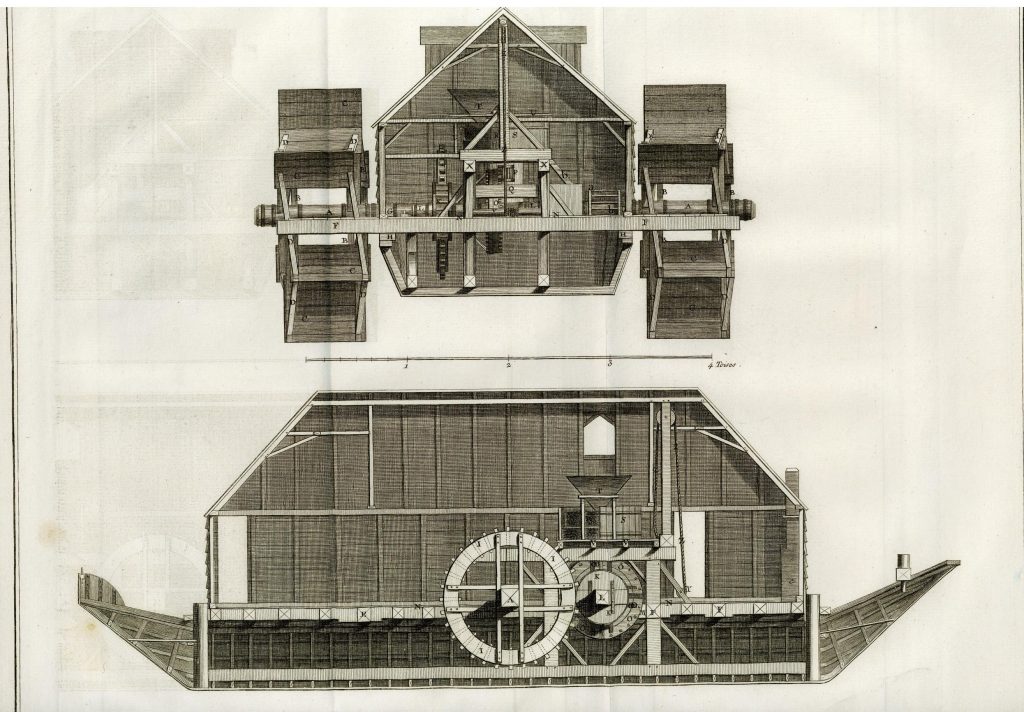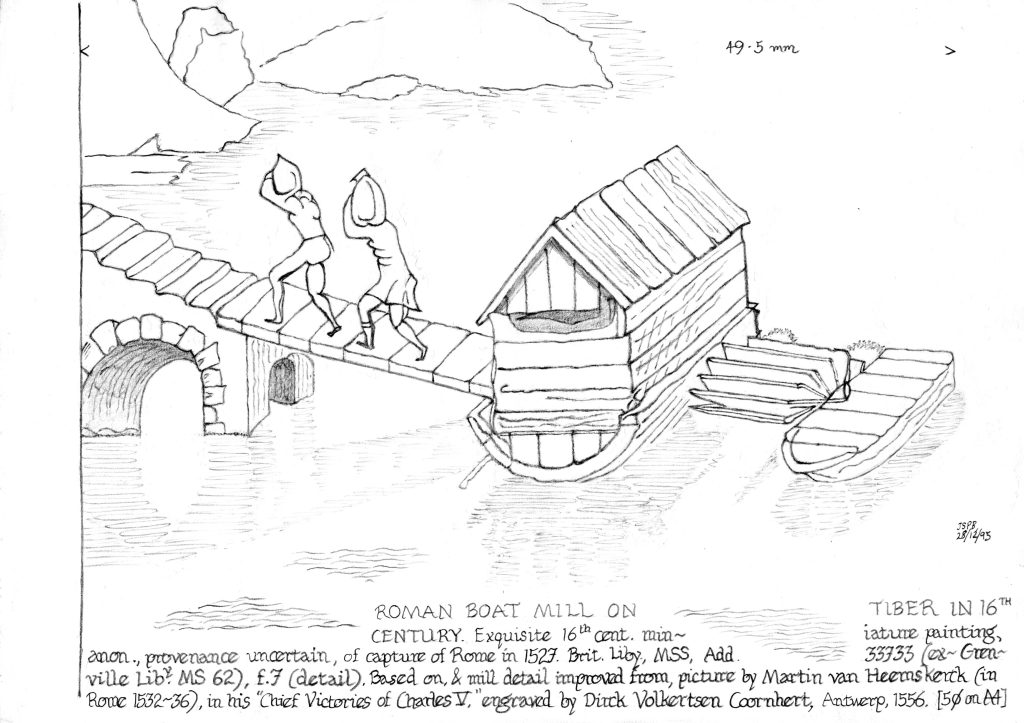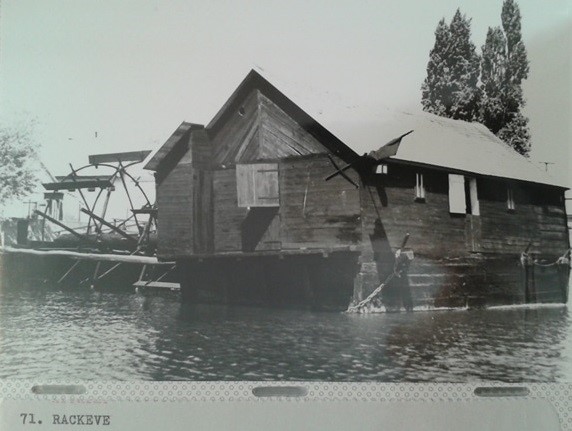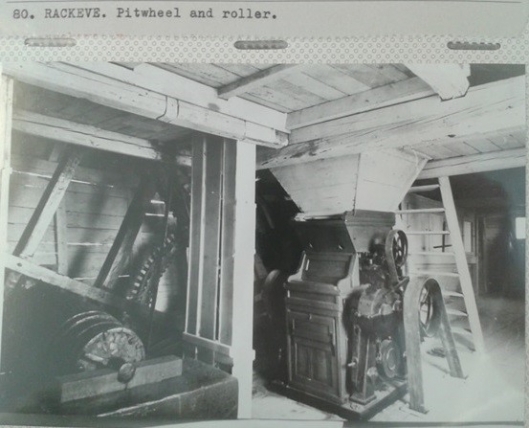| This article first appeared on our blog in January 2018. |

Boat Mill, 19th century (Mills Archive Collection, MCFC-ENG-064)
| If asked to name traditional mills, most people would probably name windmills, watermills, possibly tide mills, but less would name ‘floating mills’, also known as ‘boat mills’ or ‘ship mills’. These were structures that had the outside appearance of a watermill but were built on floating platforms and then moored to the river bank. These types of mills could rise and fall with the river, whereas a fixed watermill could not. Therefore, these types of mills were particularly popular in Europe on vast rivers such as the Danube, where the water level could change 7-10 metres during a year. These floating mills, invented by Belisarius in the 6th century to save a besieged Rome from starvation, tended not to alter much in design over time. |

Roman Boat Mill on Tiber, drawing by Stephen Buckland, 28 December 1995 (Mills Archive Collection, JSPB-ODR-384)
| However, by the time roller milling was invented at the end of the 19th century, floating mills were beginning to decline. A stalwart of European rivers for centuries, they were now starting to disappear. In France, the longest lasting mills were located on the Rhone, but only survived until 1894. Mills located on the Rhine lasted until the 1920’s whilst in Britain, the phenomenon had never really established itself. However, on the Danube mills lasted further into the 20th century, up to and including the 1950s and 60s. |

The floating mill at Ráckeve, from the Josef Sisitka Collection
| One such example was at Ráckeve in Hungary (the above image shows this mill). In 1863 there had been 4,301 floating mills located in Hungary, including this mill at Ráckeve. At some point during its history, roller machinery was installed. Details about this installation are unclear but c.1960s images of the mill held at the Archive, before the mill sank in 1968, prove that roller machinery was definitely installed. Furthermore, this mill has now been rebuilt, following written records, photos and drawings, and as such, has been built with roller machinery. This restored floating roller mill is now open to visitors, and can even be seen working on some days. |

The interior of the floating mill at Ráckeve, from the Josef Sisitka Collection
| Whilst the general Belisarius invented floating mills to save a besieged city from starvation, the British Colonial Office came up with a different solution to a similar threat. The islands of Malta, located in the Mediterranean Sea, were once a British colony. As such it came under heavy bombardment during the Second World War as the Axis Powers tried to neutralise this British base in the Mediterranean. The islands were blockaded and at the point of starvation when a British convoy finally made it through in August 1942. Ten years after the conclusion of the Second World War there were concerns that another war may be imminent, this time nuclear. There were concerns that that Malta may again be cut off so the British Colonial Office decided to take precautions and build eight new mills, to enable the inhabitants to provide a staple diet for themselves if needed. These eight mills were duly built and Thomas Robinson and Son of Rochdale were hired to install the roller milling machinery. These mills, however, were different from ordinary mills as they were all located underground. The eight mills were all excavated into live rock and were built to be self-sufficient. Underground silos, some capable of holding up to 1,000 tons of wheat, were built with access points to the surface. Diesel engines were installed to power the machinery which then ran automatically, the main role of the miller being to make sure the bags of milled grain did not overflow! Thankfully these mills were never required but were kept in working condition, at least until the 1970s with full-time watchmen ensuring the machinery was clean and ready to use if necessary. Since then many of the establishments fell into disrepair. However, on the island of Gozo, the mill built in the village of Xlendi has been restored with the shining blue Robinson machinery still on display. Click here to view some images of this restored underground mill on its own website. So, the next time you imagine what a mill with roller machinery in may look like, perhaps picture an underground location or a building floating on the Danube! Sources: http://www.industrialheritagehungary.com/02-Industrial-Heritages/01-Food/rackeve-boat-mill.html http://www.lowtechmagazine.com/2010/11/boat-mills-bridge-mills-and-hanging-mills.html https://gozo.news/55818/the-xlendi-underground-flour-mill-officially-inaugurated-today/ Sisitka, Josef, ‘Floating mills in London: an historical survey’, Industrial Archaeology Review (1997), 21-30. |
| Here are some more images of boat mills in our catalogue: https://catalogue.millsarchive.org/floating-mills |

